During a trip to Slovakia, I found the first meteorite specimen which fell near the village of Pusté Úľany on June 25, 2022. It is also the first meteorite I have ever discovered. I donated my find to scientific purposes and left it in Bratislava, but I will remember the whole trip forever.
Firstly, let me explain what happened in the sky on June 25 and why I visited Slovakia. On that day, a bolide was observed at 7:54 PM (local time) and was clearly visible in the still-brightening sky. Although the cameras of the Czech bolide network had not yet been turned on, the meteor’s flight was recorded by devices that conduct 24-hour sky monitoring. They have a narrow field of view, but were fortunate to observe exactly the section of the sky where the bolide appeared. The recordings from cameras in Veselí nad Moravou and Kuchařovice u Znojma, as well as in the town of Hurbanovo in Slovakia, made it possible to determine the trajectory of the flight and calculate a potential meteorite landing site. As usual, the calculations were handled by scientists from the Astronomical Institute of the Czech Academy of Sciences – Pavel Spurný, Jiří Borovička and Lukáš Shrbený.
The meteoroid weighed 50 kg before entering the atmosphere and became heavily fragmented at an altitude of 28 km and (probably) 23 km. Despite the loss of a huge part of its original mass, small fragments were supposed to reach the ground – the largest of them should have weighed from 100 g to about 500 g, but in this case the Czech researchers wrote rather about „single specimens”. In conversations, they also mentioned that the existence of specimens above 100 g is not certain. On the other hand, more meteorites weighing a few or tens of grams were to be expected.
For two months, the meteorites were searched for by scientists, local residents, collectors, and astronomy enthusiasts – including organized professional searches. To no avail. So I asked myself whether it was definitely worth going there and trying my hand.
Well, of course it’s worth it!
In the end, I went on the expedition with Jaroslaw Morys – a collector and meteorite hunter who has been tracking the freshest meteorite falls for several years.
A dream start
August 20, 2022
On the first day of the search, we decided to focus on the part of the strewn field where the smallest meteorites were expected to land. When we parked the car and looked at the fields, we immediately saw that it would not be easy. A large part of the fields in the northeastern part of the indicated area was densely covered with sunflowers and corn, and the remaining fields had already been plowed by farmers. Nonetheless, we set out to search and spent a few hours on one field previously overgrown with corn. We were trying not to miss even the smallest stone. Around 3:00 pm we decided to do some reconnaissance before the next day in an area of slightly larger meteorite masses. This decision turned out to be exceptionally accurate.
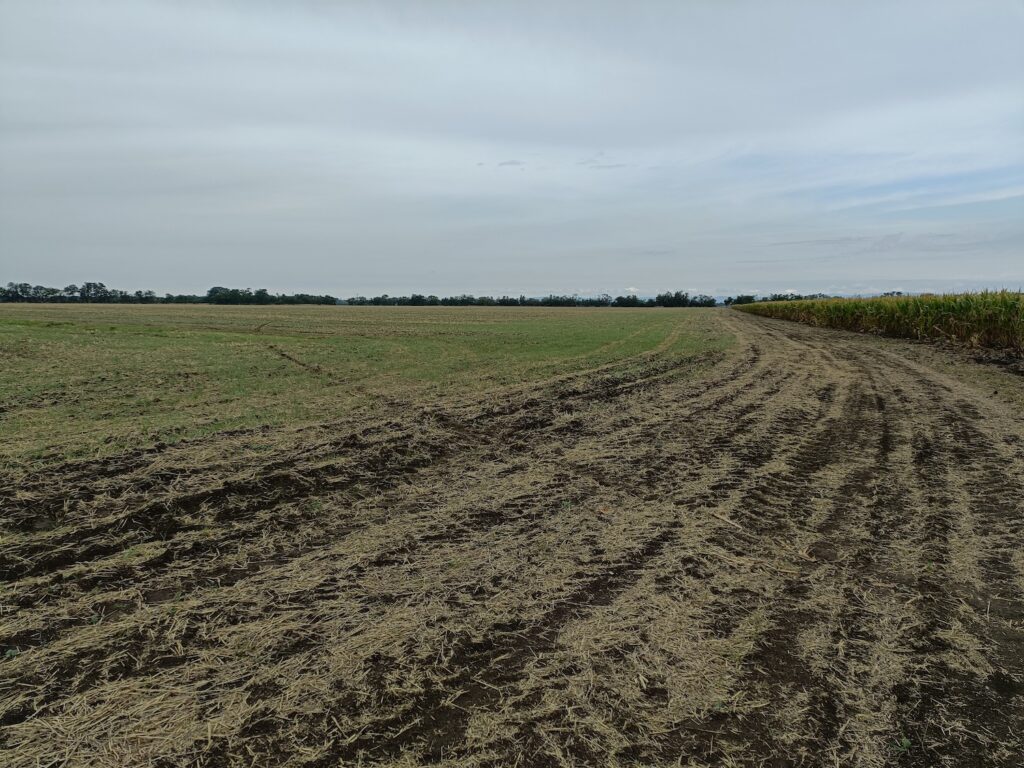
We tore through a narrow strip of forest and sunflower plantations to reach another field after initial plowing, which did not look promising at all. We decided to walk around in different directions, and not to waste time searching „shoulder to shoulder” in a place where meteorites may already be underground.
Before setting off deep into the field, I made several turns near the road, as I still wanted to search the area as thoroughly as possible. At the next turning, I noticed a small, black stone with rounded edges on the ground. I had already seen many of them that day, and some of them were even magnetic. This time, however, I came across a real meteorite! The specimen was turned with its interior to the moist soil and slightly sunk into the ground. It immediately sticked to the neodymium magnet with which I was checking for potential meteorites, and I became stunned. I had never found a meteorite before, much less the first specimen from a new fall.

At first I wasn’t even sure if it was actually a meteorite – I’m perfectly familiar with their appearance, but emotions instantly took over and interfered with an objective assessment of the find. Euphoria alternated with disbelief.

I shouted to Jarek, who was already a few hundred meters away, and then ran to him with the specimen. A joint inspection confirmed that my dreams had come true. The fusion crust on the specimen was fresh, black and very distinctive, while the break was completely brown. There was no time to clean the meteorite – after a quick documentation of the find, the decision was made to flee to the car. A storm with a heavy downpour came over the fields. Within minutes or so, the searched area became muddy and deep puddles appeared.
Back at the motel, I rinsed the meteorite of mud and debris to get a closer look. The specimen, after cleaning and preliminary drying, weighed 8.6 grams, and its interior looked a bit weathered.
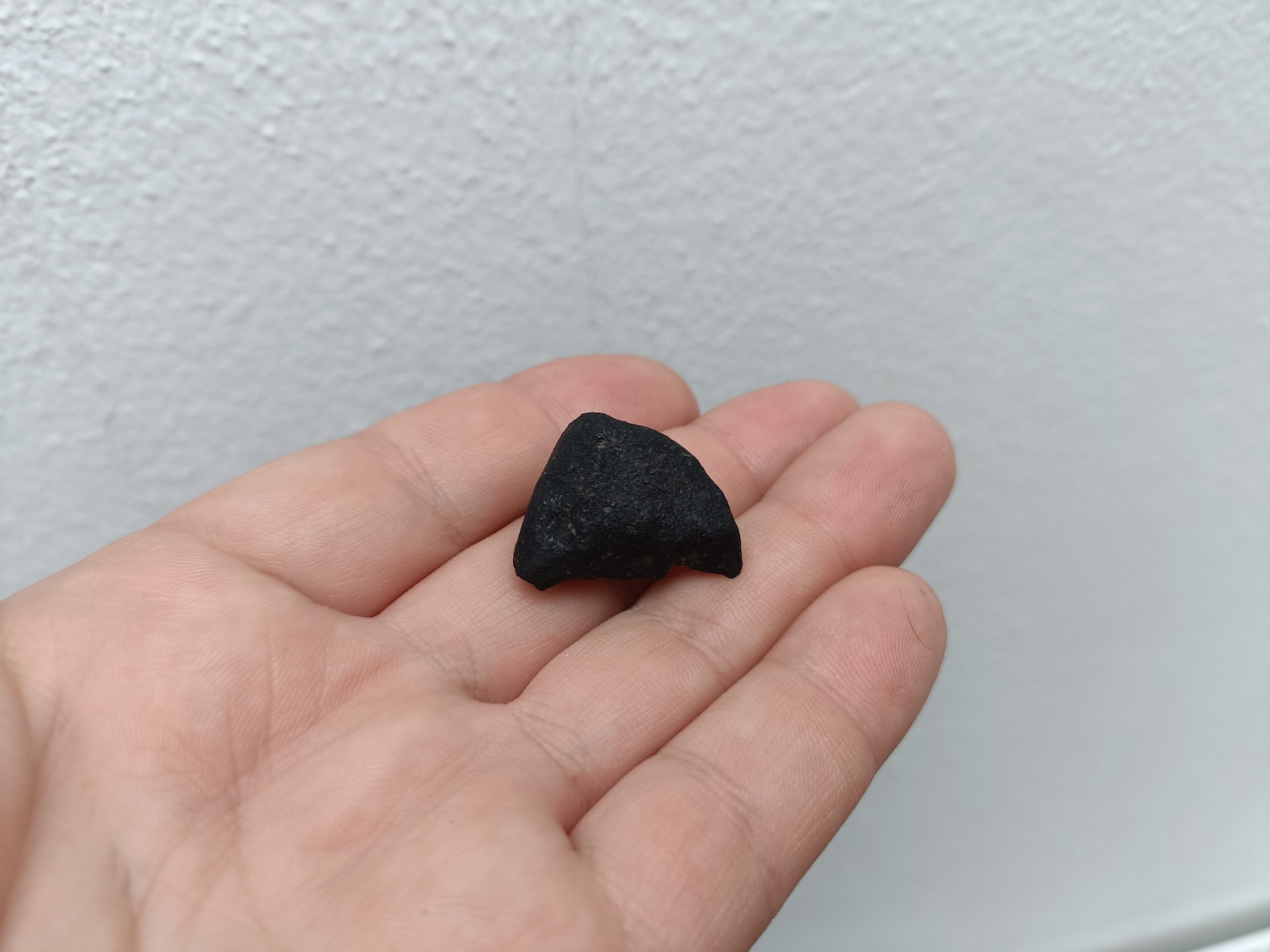
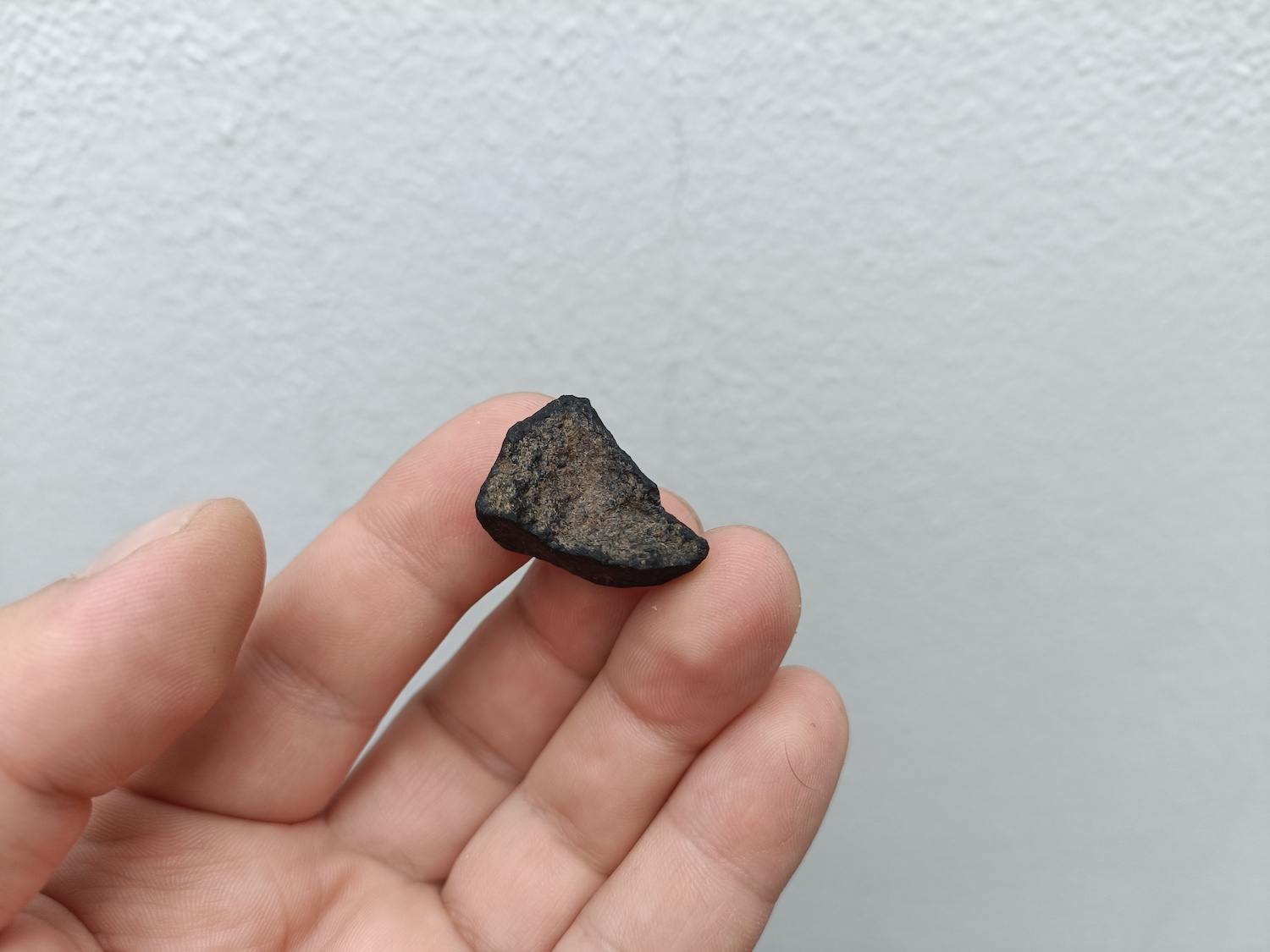
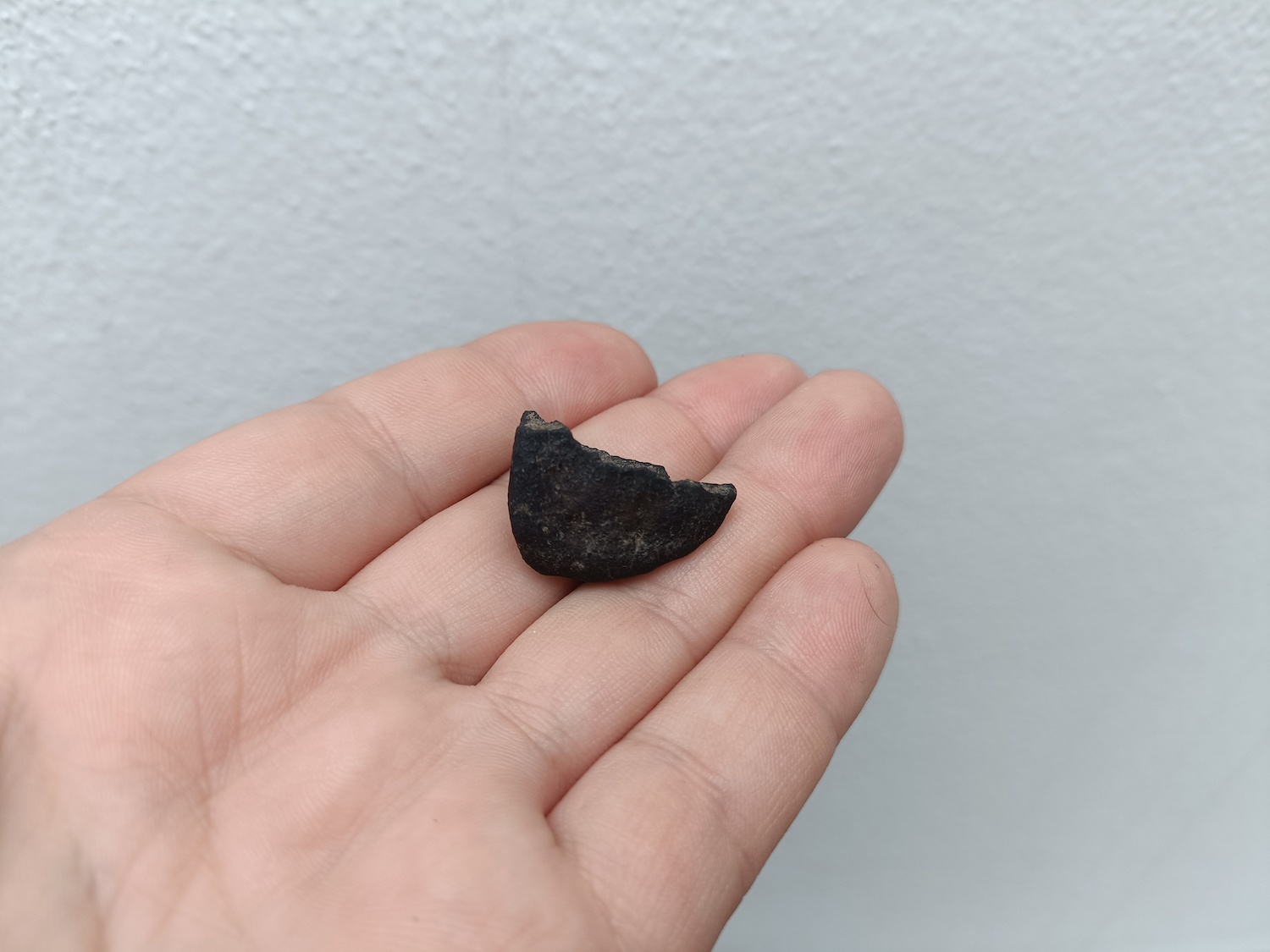
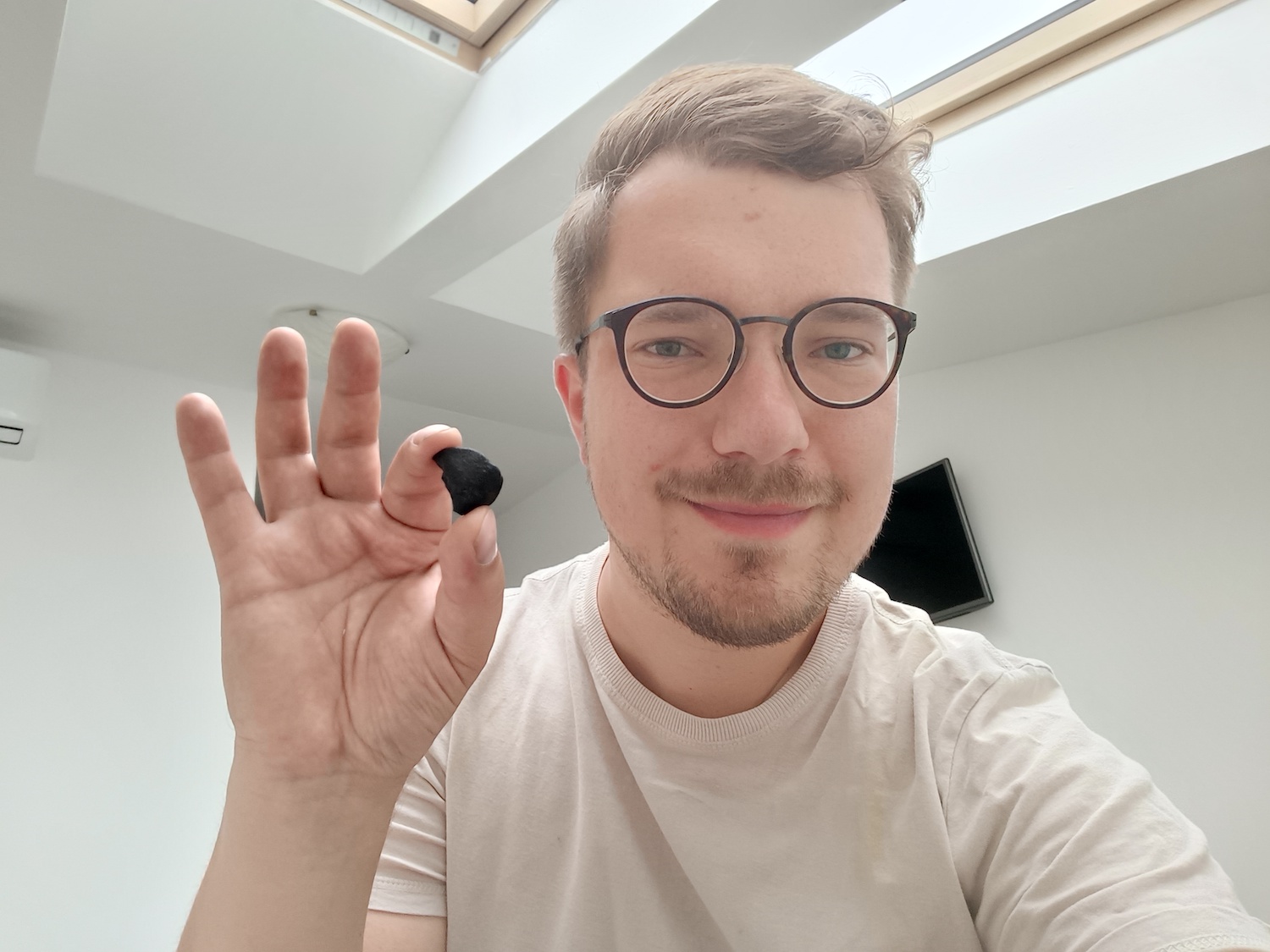
This made me realize that the time to find more specimens is really short.
Praying for the Sun
August 21, 2022
On the second day we were in the strewn field around 9:00 a.m. We concentrated on the field where the first specimen had been found the day before. We walked the first few kilometers close together so as not to miss any possible specimens weighing less than 10 grams. After a long time, however, we decided to split up – the other parts of the field were more heavily covered with straw and crop residue than the find spot, so they offered a much lower chance of success.
Jarek decided to try his luck in the field of sunflowers, while I continued walking in the same field. A few hours later, we met to conduct a short reconnaissance of the northeastern part of the strewn field. There we met the host, who was clearly curious about our search. During a brief conversation, we learned that there had already been many prospectors in the area, and that most of the fields in the area had already been plowed. Well, we were not surprised.
A few minutes later we were caught in another downpour. Jarek tried to continue the search under an umbrella, and I had to return to the car – completely soaked clothes and strong wind is not a very comfortable combination.
After returning to the motel and putting on dry clothes, we went to the potential area of the fall of the largest meteorite specimens – from 50 to 200 grams. There, two surprises awaited us. It turned out that one of the most promising fields was still densely covered with corn, and a river flowed nearby, hidden in even denser grass. Fortunately, behind the river stretched a huge, mowed meadow.
It was this area that seemed worth searching another day….
Double luck
August 22, 2022
Not all gold glitters. The meadow in the area of the larger meteorite masses had been mowed, but apparently a few weeks earlier – grass reaching up to mid-calf had managed to grow on the mowed blades. In contrast, a section of the field lying closer to the projected landing site of the main mass was already completely plowed. Not discouraged, we searched the grassy area thoroughly, and then circled a little faster around the plowed part of the field. A possible meteorite should immediately catch your eye – a 50-gram specimen is not so small after all, especially when you walk with your eyes fixed on the ground! Unfortunately, several hours of wandering around the field yielded no results. What’s more, dark clouds arrived over our heads, threatening a repeat of the previous days’ search. We had to evacuate to the car.
We drove in the rain and frantically checked satellite images. We quickly noticed that the biggest downpour was likely to miss the field where I managed to find the first specimen. We returned there to continue our search in places where the straw did not completely cover the ground.
After another two hours, as it was getting darker and I was slowly making my way to my car, I heard the intro to „Smoke on the water.” My phone rang. It was Jarek.
– What’s up?
– Mati, I think I got it.
– Okay, I’m running to you.

Half a minute later I was already with Jarek, who was proudly examining the specimen he had found. As with my find, its part was broken off, but the size was clearly larger. Satisfied, Jarek took photos of the specimen and later weighed it – more than 10 grams! From then on, we both had our finds. We had discovered what we were looking for and were incredibly happy.
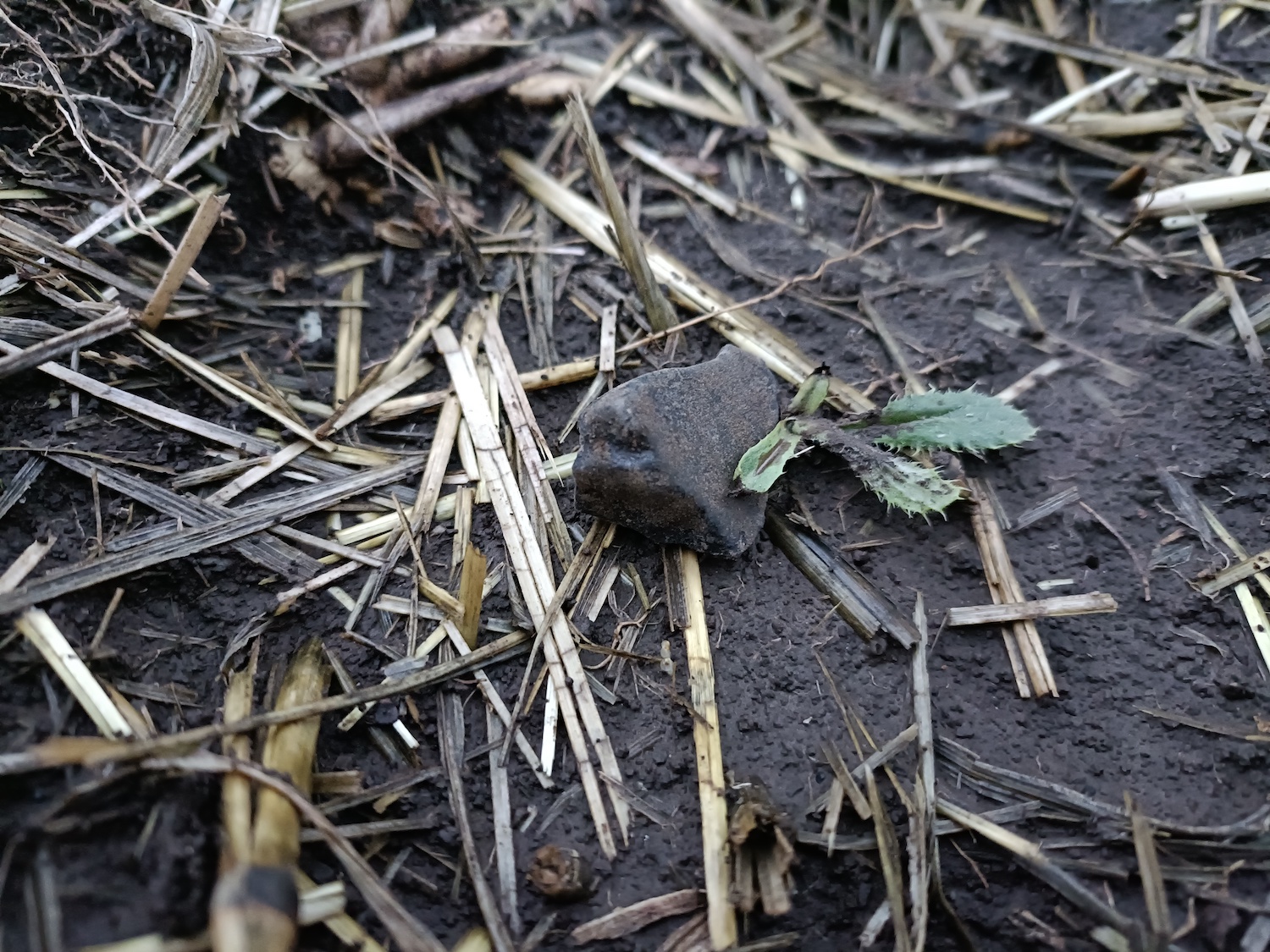
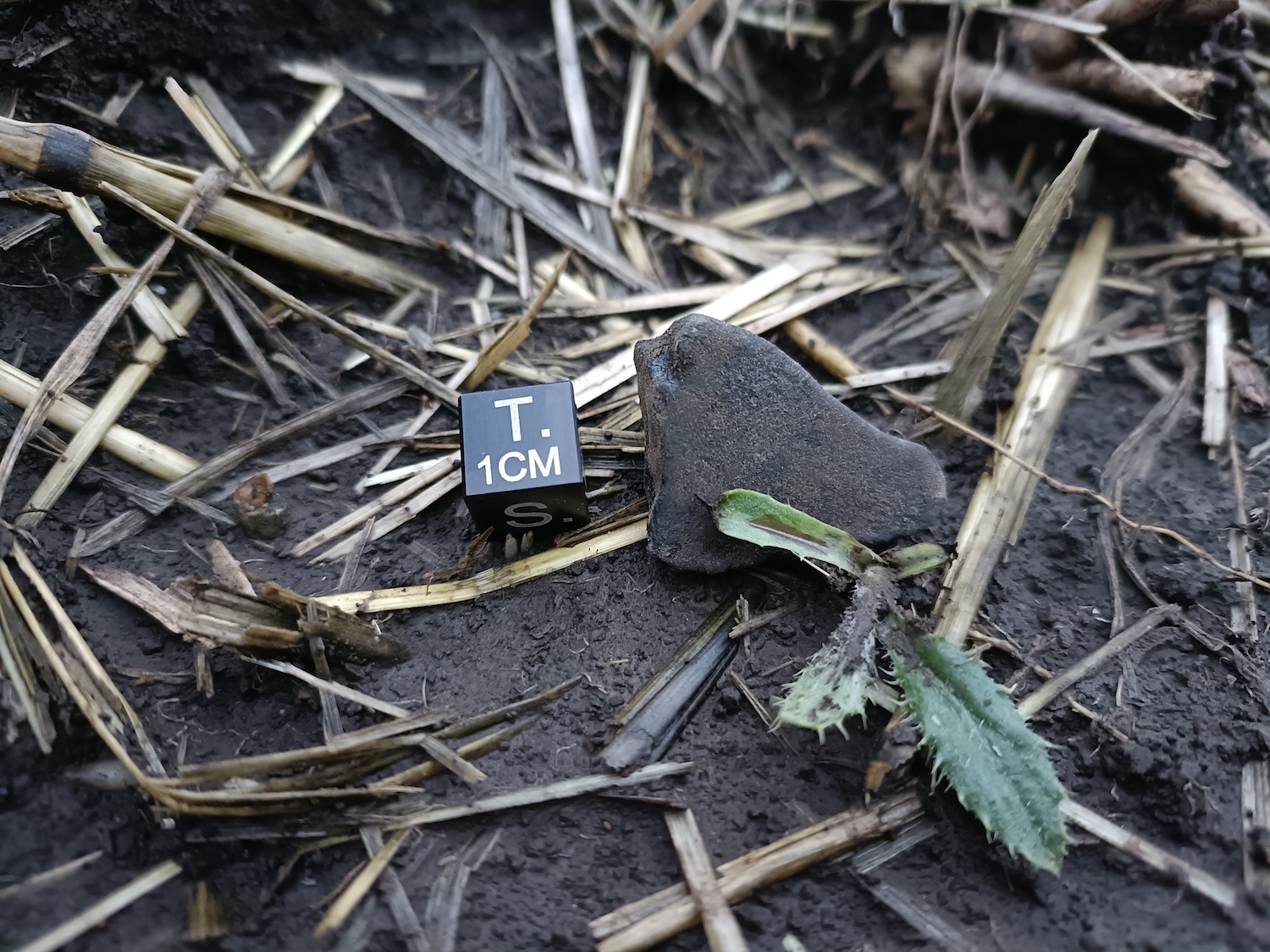
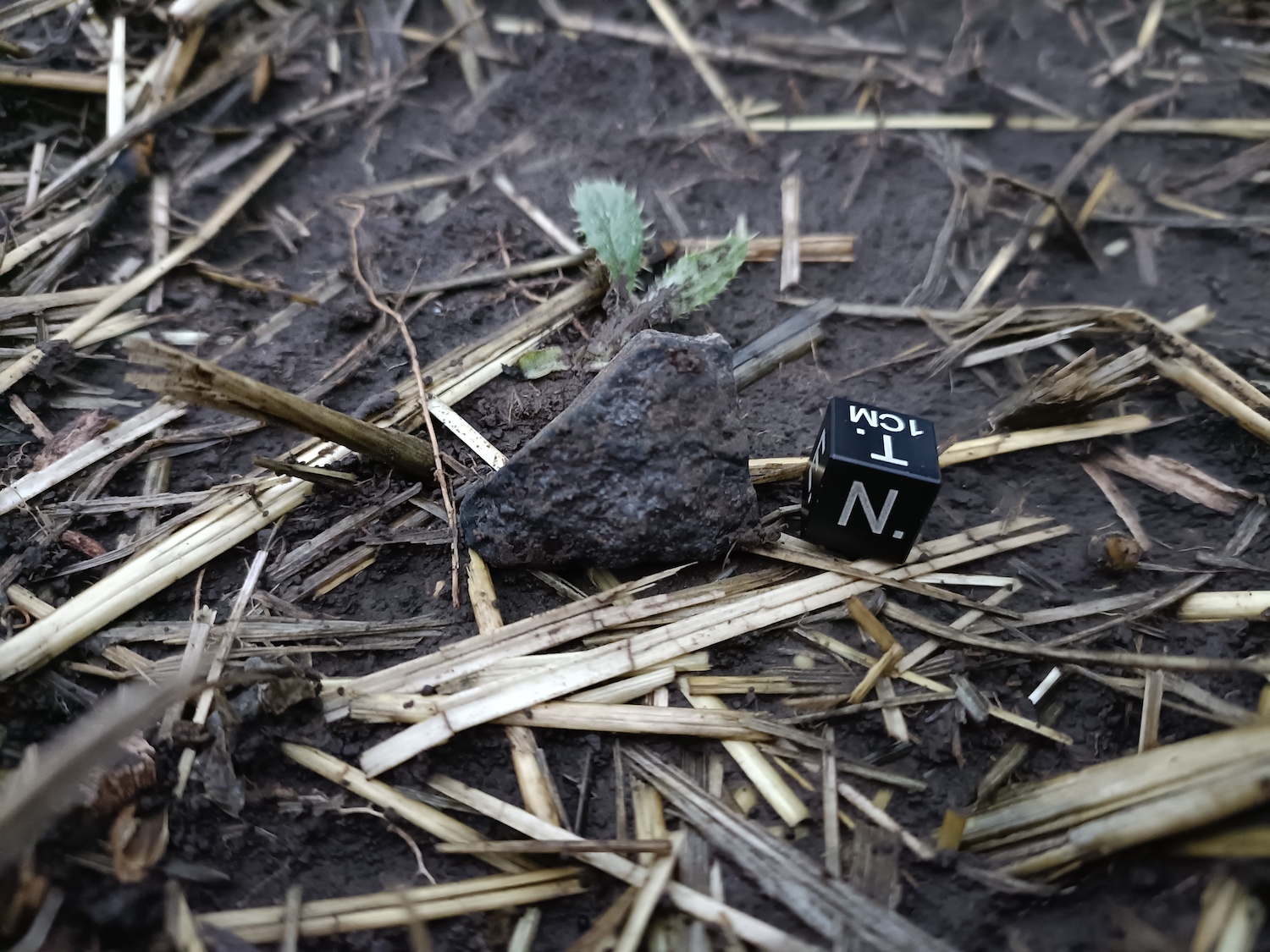
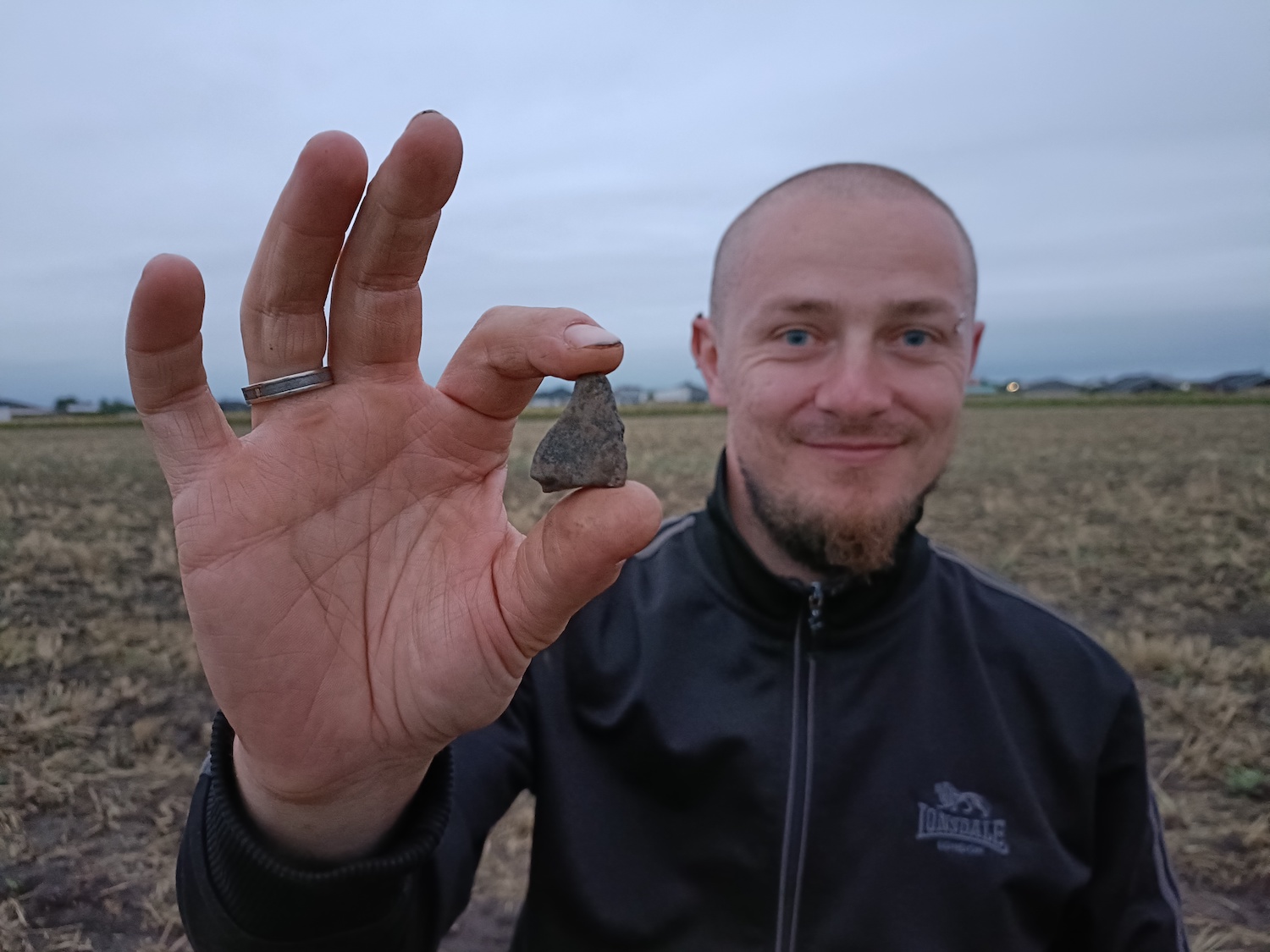
For a long time I congratulated Jarek on his hawk-like eyesight. His meteorite was more heavily soiled after two days of rain and was not as easy to recognize as mine. The old truth of prospectors was confirmed – you’re not sure, apply a magnet. It’s better to test several times for nothing than this one time not to test a real meteorite with a magnet.
By the way, in the „happy field” I also found… a horseshoe. Doesn’t that speak for itself?

Meeting at the university in Bratislava
August 22, 2022
Shortly after waking up, I wrote an email, which was received by Pavel Spurný of the Czech Academy of Sciences and Juraj Tóth of Comenius University in Bratislava. In it, I included a detailed description of the meteorite I had found, the circumstances of the find, and included full documentation – photos of the specimen, coordinates, as well as the results of a „photo shoot” realized in a motel, when the meteorite was already pre-cleaned. I also inquired about the possibility of meeting in the Slovak capital to hand over the specimen for study. Very quickly I received a response from both researchers – Pavel congratulated me on my find, and Juraj connected me with his colleagues, to whom I drove right after breakfast.
On the way, I wondered what our meeting would be like. I was greeted at the door of the Department of Mathematics, Physics and Computer Science at Comenius University by Dr. Pavol Matlovič, and then we went to his office. Together we viewed the meteorite, exchanging very interesting observations about the fall. We also talked about the expedition organized by the university, which took place a few weeks earlier, and about future expeditions.
After that, more researchers started coming to the office – each of them was very happy to see a small black pebble from space. Among them was Professor Pavel Povinec, with whom I went to the laboratory and left the meteorite for the study of short-lived radioactive isotopes and classification. During the meeting with the professor, I had the opportunity to learn a lot about isotope analysis, see the apparatus used for this, and receive another portion of thanks and congratulations.
Cosmic joy!
My smile accompanied me all the way to Krakow. It was an amazing trip, during which I fulfilled at least four meteorite dreams. I wanted to go on an overseas expedition, to find a meteorite, to discover the first meteorite from an observed fall, to provide scientists with a new meteorite, and to be able to see the specimen I found in a museum exhibition.
Of course, I still have to wait a little longer to realize the latter dream, but according to the Slovak researchers’ announcement, the specimen will definitely be presented to a wider audience.

Supplement
After the first meteorite was found, further expeditions took place in the vicinity of Pusté Úľany, with no results. Although metal detectors were used and several people took part in them. I myself spent another three days in Slovakia in September, searching for meteorites with a professional detector. Unfortunately, I was also unsuccessful.
The 8.6 g specimen I found is currently being tested for short-lived isotopes. Preliminary results have confirmed that it fell to earth recently and came from a bolide seen on June 25 over southwestern Slovakia, the Czech Republic and Hungary. Once these tests are completed, official classification of the specimen will begin, which will determine its type. Most likely, it is an ordinary chondrite, which is a stony meteorite containing spherical rock grains and metal particles. After the research, it will remain in Slovakia and will probably end up in a museum.
Jarek, on the other hand, has decided to keep his find and make it available for research in Poland. This meteorite is also being analyzed for cosmogenic isotopes at the moment. After the research, Jarek would like to leave it in a private collection.
Due to further exploration by researchers from Slovakia, I would not like to give the exact place where the fragments have been found so far. I will only write that the predictions of the researchers from the Czech Republic came true in full – the meteorites were found in the area they designated, according to the predicted distribution of the masses of the individual fragments.